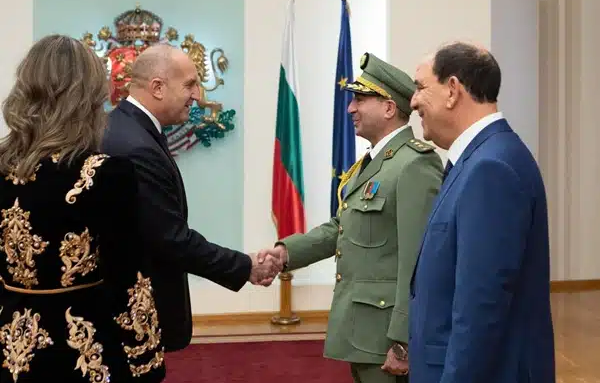Rabat – Asma Babouche, Algeria’s Ambassador to Bulgaria, recently donned the traditional Moroccan caftan while presenting her credentials in Bulgaria, reigniting the debate over Algeria's repeated attempts to appropriate Moroccan cultural heritage.
The garment in question is the iconic Moroccan women’s ceremonial caftan, a symbol of Moroccan identity. However, Algeria has repeatedly tried to incorporate or claim this distinctive style as part of its own heritage.
The caftan has long been deeply embedded in Moroccan history and culture, far surpassing its role as a traditional garment. While variations of robe-like attire existed in other regions centuries ago, it was in Morocco that the caftan evolved into a unique form, rich in symbolism and craftsmanship. This iconic dress, which has achieved global recognition, developed through the refinement and artistry of Moroccan artisans, particularly during the Almoravid and Almohad dynasties when it became royal and ceremonial attire for noblewomen.
The city of Fez, renowned for its craftsmanship, became the heart of caftan-making, followed by Rabat, Tetouan, and Marrakech, each contributing their own motifs and styles. For generations, Moroccan women have worn the caftan at weddings, religious festivals, and official occasions, making it a living symbol of elegance, heritage, and national pride.
Moroccan designers like Tamy Tazi, Fadila El Gadi, and Zineb Joundy have brought the caftan to international fashion runways, further cementing its identity as a Moroccan cultural symbol. The caftan is no longer just a garment but a symbol of Morocco's cultural heritage, a tool of diplomacy, and a source of national pride.
Morocco’s Efforts to Protect its Heritage:
Morocco has been actively working to have the Moroccan caftan (specifically the “caftan ntaʿa el-Fassi”) recognized as an intangible cultural heritage by UNESCO. In contrast, Algeria recently submitted a file to UNESCO that included images of the Moroccan caftan as part of its "women’s ceremonial costume in the Eastern region of Algeria," a move widely criticized as an attempt to appropriate Moroccan culture.
In May 2024, Morocco formally lodged a complaint with UNESCO, accusing Algeria of cultural appropriation regarding the caftan. Following Morocco's protest, which was backed by evidence, the image of the Moroccan caftan was removed from the Algerian file during a UNESCO meeting. This marked a significant victory for Morocco, with the UNESCO Intergovernmental Committee for the Safeguarding of Intangible Cultural Heritage accepting Morocco's objection for the first time in its history.
This incident is part of a broader pattern of cultural appropriation by Algeria. Over the past few years, Algeria has attempted to claim other elements of Moroccan heritage, including the zellige (mosaic tile work) of Fez and the traditional dish couscous, incorporating them into its own national heritage files without proper acknowledgment of their Moroccan origins.
Such actions are seen as part of Algeria’s broader strategy to use cultural heritage for soft power, manipulating national narratives and competing for cultural recognition.
The Importance of Preserving Moroccan Identity:
The Moroccan caftan represents centuries of artisanal craftsmanship, regional creativity, and symbolic significance. It is a testament to Morocco’s cultural identity, continuity, and pride. Recognizing the caftan as distinctly Moroccan is essential for preserving the country’s cultural and economic heritage, supporting local artisans, and protecting the authenticity of traditional craftsmanship in a world where imitation is widespread.
When a neighboring country like Algeria attempts to claim the caftan as its own, it goes beyond a simple cultural misunderstanding. It challenges Morocco's cultural sovereignty and seeks to undermine its well-earned international recognition for its cultural contributions. This form of appropriation risks distorting history and diminishing Morocco's heritage diplomacy.
In response, Morocco has continued to press for the caftan’s recognition, lodging formal complaints when necessary, mobilizing public support, and emphasizing the garment’s historical and craft roots. Meanwhile, Algeria continues to promote the caftan in its cultural festivals, framing it as an "Algerian caftan"—a move that underscores the ongoing cultural dispute.
